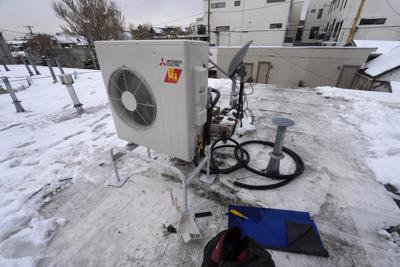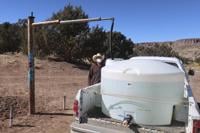Federal incentives for home energy improvements are running out at the end of the year, so it's decision time for anyone who has been thinking about a heat pump. The right decision can depend on where you live, how much you have to spend and how deeply you want to cut emissions.
But the payoff can be significant.
Bill Gerosa was spending about $6,700 annually to heat and cool his house about 30 miles (48 kilometers) north of New York City. He was eager to bring down his costs, and shelled out $13,000 for a ground-source heat pump that was made more affordable by significant state and utility incentives.
ŌĆ£I had to prove to myself and to my wife that I wasnŌĆÖt doing something monumentally stupid,ŌĆØ he said.
Gerosa's monthly energy use plunged by two-thirds. He installed solar panels at the same time to offset the rest, and his heating and cooling bills fell to virtually nothing. Last month ŌĆö about seven years after installing the system ŌĆö he's recovered what it cost to install the system.
Heat pumps 101
The simplest way to understand a heat pump is that it uses electricity to gather heat from one place and move it to another. Heat exchangers, compressors and refrigerants are part of the system. That's how it can work not just for heating but for cooling ŌĆö in summer, a heat pump can pull warm air from a house and push it outside.
That's also the secret to how heat pumps can be more efficient than conventional heating technologies, which have to generate heat before they can distribute it. It takes a lot less energy to simply transfer heat, according to the .
A decade ago, heat pumps could struggle when it got really hot or really cold outside. But advances in technology mean today's heat pumps can keep homes cool even in and warm even when it's .
There are of heat pumps: air source and ground source. Air-source heat pumps work with the air around the heat pump. Ground-source heat pumps ŌĆö also known as geothermal ŌĆö use pipes that circulate liquid underground to either gather or discharge heat.
Air-source pumps cost less to install and require less space since there's no need to run underground pipes. But operating costs are higher than ground-source pumps. They're most effective in more moderate climates.
Ground-source pumps cost more up front and installing hundreds of feet of underground piping can be disruptive to lawns and gardens. But they're more efficient and cost-effective in the long run because underground temperatures are far more constant than air temperatures.
ŌĆ£TheyŌĆÖre seeing the ground temperature of about 50 degrees, not the outside air temp. So thatŌĆÖs where they really dominate on efficiency, payback, energy bills, peak demand on the grid, all of those things,ŌĆØ said Ted Tiffany, senior technical lead for the Building Decarbonization Coalition, a nonprofit that advocates for green energy use in buildings instead of fossil fuels.
Panama Bartholomy, the coalition's executive director, noted that a heat pump costs more than a gas furnace or central air conditioner, but can do the work of both.
Drilling for the underground piping that a ground-source pump requires can add around $10,000 to the project. The U.S. that the added installation costs are recouped within 5 to 10 years thanks to the higher efficiency.
Heat pumps are cleanest
Heat pumps are also cleaner than systems powered by natural gas options, even if the electricity used to power heat pumps is primarily generated from coal. That is because heat pumps are three to five times more efficient. The National Renewable Energy Laboratory found that almost everywhere in the United States, switching to a heat pump .
ŌĆ£We should do it now, pretty much everywhere," said Mike Henchen, buildings program principal for the clean energy nonprofit RMI.
Henchen said RMI's found the biggest improvement happens in states with milder weather and with more clean-energy options like wind and solar to provide the electricity. ŌĆ£If you live in Southern California, thatŌĆÖs probably amazing. ItŌĆÖs probably five times better than a gas furnace on efficiency. If you live in North Dakota, maybe itŌĆÖs only two times better because itŌĆÖs cold in winter and that diminishes the performance.ŌĆØ
Technician availability: the oldest tech still wins
Tiffany said it's typically easiest to find someone to replace what you already have.
ŌĆ£If you've got an oil furnace, a guy's going to try to come sell you an oil furnace because it's the easiest thing that goes back in," he said.
But the newer technology is catching on. Heat pumps have since 2021. They outsold by their last year.
Bartholomy said as heat pumps have gotten more common, most HVAC professionals can install one because the technology isn't that different. It's the ground source heat pump installers that are more difficult to find.
ŌĆ£It's far less availability of contractors. And so, supply and demand, usually you don't have a lot of options to get bids and be able to negotiate price down,ŌĆØ he said.
There are that show geothermal installers nearby. And it can take time for professionals to learn how to install new technologies, Bartholomy said. ŌĆ£That is disrupting what has been a status quo for 75 years. And it's just different. It's just not what they have installed time and time again in their region.ŌĆØ
___
The Associated PressŌĆÖ climate and environmental coverage receives financial support from multiple private foundations. AP is solely responsible for all content. Find APŌĆÖs for working with philanthropies, a list of supporters and funded coverage areas at .














































